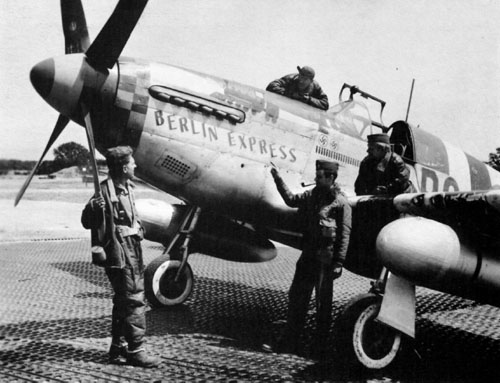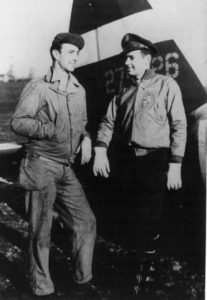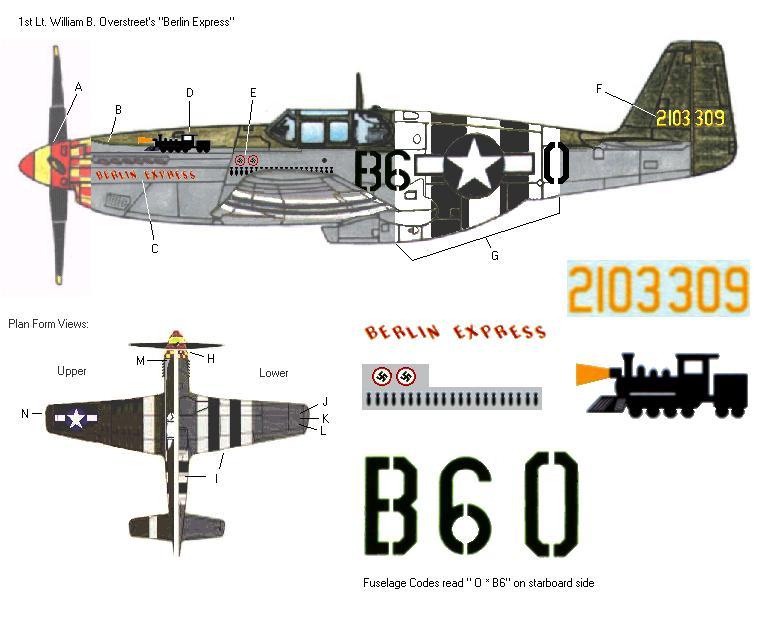357th FG Profile

1st Lt. William B. Overstreet’s P-51C Mustang “Berlin Express”

Lt. Bill Overstreet (R) rode his Mustang for well over an hour while unconscious due to a flak damaged oxygen line. At lower altitude he woke up and recovered just above the trees
 Modeler Tips:
Modeler Tips:
a. Rear red band on propeller boss extends onto spinner to leading edge of blades when in neutral pitch. Determine width of yellow band by dividing remainder of spinner evenly.
b. Dark olive green anti-glare paint tapers away from cowl seam starting gradually at firewall then steepening as you move up to the checkered nose band.
c. “Berlin Express” occupies vertical 2/3 of lower strip panel from first exhaust stub to roughly halfway between end of the exhaust manifold to the firewall. Typeface is very similar to TW Century MT Condensed with each individual letter tilted back at 70-degree angle.
d. Locomotive nose art rests above cowl seam with the wheels barely touching the seam.
e. Two kill markings- black swastikas on white circles with red borders- 21 black bomb-style mission marks tucked in beneath.
f. Tail Number in yellow- “2103” on fin, “309” on rudder.
g. Full suite of invasion stripes, wings and fuselage- fuselage codes in black.
Upper & Lower View Notes: SAFETY TIP- this view shows the aircraft after it received it’s new “Malcolm” perspex hood and had the invasion stripes reduced in the weeks following D-Day. For actual D-Day period paint full invasion stripes over top of wings and fuselage and use framed three-piece canopy.
H. Width of checker reduced on underside in order to fit evenly on the narrow surfaces of the chin scoop area.
I. Full suite of invasion stripes on undersides of wings, reduced to level of olive green paint on fuselage. White recognition stripes were of standard widths on wings & stabilizers for mid-1944 ETO Mustangs.
J, K, L. Red, Green, Yellow navigation lights- circular and flush with wing panel.
M. Dark olive green anti-glare paint tapers away from cowl seam starting gradually at firewall then steepening as you move up to the checkered nose band.
N. Formation Lights- Red (Port) and Green (Starboard)
Overall Modeling Tips:
*This aircraft wore Olive Green upper surfaces, natural aluminum beneath. Paint on the flat colors first (invasion and/or recognition stripes, upper camouflage) first- then mask off those features and paint the remainder of the aircraft in natural aluminum color. Most metal colors will be marred or removed by masking materials.
*Tires and tail wheel were painted with whitewalls on sides from hub to tread.
*After building several 357th A/C over the past 30 years, I recommend painting the nose area forward of the exhaust cutout yellow when the flat features are painted. Carefully cut away the yellow squares from the checkerboard decal and apply the remaining strip of red checkers to the nose. This method significantly reduces the potential for bubbles and wrinkles, plus it makes exact alignment of the decal easier.
*Prior to assembly, wash clear plastic parts with a mild glass cleaner and gently wipe dry. Then use a Q-Tip to evenly spread clear liquid floor wax (Future Brand seems to get the best results) on both inside & outside. Protect from dust and let dry for at least 2 hours. The wax fills in microscopic flaws and creates an even gloss that is clearer & shines brighter than the original plastic underneath.
Additional notes from Bill Overstreet:
Some history, my first P-51 was named SOUTHERN BELLE. It was damaged on an early mission and was replaced. By then we were going to Berlin regularly, so it was BERLIN EXPRESS. Only the express was slanted and no train or horse. The next one had both names slanted and the train added. When your Father returned to the States, I took his plane and this is the one that had the horse added. When I left, Bill Fricker took it and changed the name but kept the horse. All of my planes had red wheels and white sidewalls.
The idea of using the yellow and red like the nose markings is good but it didn’t happen at that time. As I remember, the disc was white, the horse was brown, the plane in the painting was black. White edging was used on dark colors and black edging on light background. I don’t remember any yellow or red on that painting. Are you familiar with AeroMaster Decals of Miami? They had decals of the name and locomotive and B6-O some years ago but nothing on the right side. The BERLIN EXPRESS was all slanted on some of my planes and EXPRESS only on some. Sure wish I had saved more pictures. Anyway, I hope this is of some help.
Bill Overstreet
AeroMaster Decal Sheet 48-288 and SuperScale Decal Sheet 48-691

